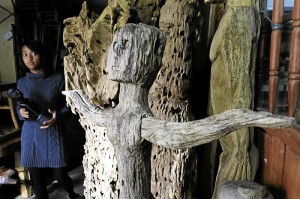
BOWLS, trinkets and other items sold by antique collector Greg Sabado come in irregular shapes. PHOTO BY EV ESPIRITU
The government ban on logging has severely affected the local furniture industry. Those using hardwood like narra, molave, yakal, rosewood and kamagong are particularly hard hit; most are now using salvaged or recycled timber for tables, chairs, bowls and other decorative pieces.
One Baguio furniture designer and antique collector has found an unlikely source and it would take acts of nature to get through them.
Greg Sabado, who owns Sabado’s Handicrafts on Outlook Drive in Baguio, has a wide collection of huge bowls and troughs, which are mostly irregularly shaped. Some are practically useless as liquid holder as they are pocked with holes. They are not smooth; they are lined with a bark-like texture.
They resemble more the raku pottery (hand-shaped rather than thrown) than wooden wares.
But only by holding these would one believe that trees have souls, as CNN hero and Baguio girl, midwife Robin Lim, would assert. And the souls of these wooden bowls are ancient indeed.
What seem like barks are part of the wood instead. These are carved by nature for decades, centuries even.
The kamagong bowls in Sabado’s shop are heavier and darker than the regular kamagong. They have a natural shining sheen, which gives credence to the wood’s old term as the Philippine ebony.
Buried stumps
Sabado says that these kamagong and molave bowls were taken from long-buried stumps and trunks that were logged or simply felled by storms.
In fact, he says, they were found in the jungles of Aurora province after storm-triggered landslides exposed them.
He says the Dumagat people in Aurora are particularly adept in spotting these stumps and trunks. The residents would then dig out the buried wood, clean them and shape them. Sometimes, those almost carved out by nature are sent untreated to Sabado.
They resemble columns of limestone pillars carved of millennia of raindrops. As hardwood, they withstand decay much longer than regular tropical wood.
“It is illegal to cut hardwood but not to dig them out,” Sabado says.
Sabado would then buy these elemental items and do minimal finishing like lightly sanding and varnishing them. He would have his workers turn them into huge bowls and even basins.
Hard texture
These semicarbonized wood have a very hard texture (which is why carving is kept to a minimum) and rich color. A buried molave wood is more golden than the usual molave.
The smaller bowls sell for P1,500 each while the big wooden basins sell for P7,000. The kamagong ones, darker than the heart of darkness, are particularly alluring.
Sabado says one can use these bowls to fill up with ice cubes to chill beers or fruits. The smaller bowls can be used as exotic salad bowls. Those with holes and gashes can be used as accent pieces.
Online catalogs sell the medium-sized kamagong bowls for $175, while the crafted kamagong bowls sell for $175. Molave bowls sell for $150.
Sabado also recycles huge wooden flat bowls used to feed pigs in Bontoc, Mt. Province. These bowls are varnished and can be used as table tops.